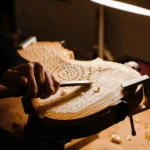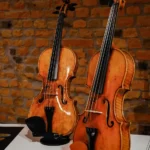Violin Bow Care: Our best tips to help you keep your bow in top condition
Back to BlogWhat is the essential violin bow care?
Your violin bow needs care as much as your violin. It is probably the most important part of your musical instrument, and it is the one responsible for generating the sound of your violin. Without it, you wouldn’t be able to play, so good care is more than necessary.
In order to keep a good violin bow in optimal playing condition, never tighten its hair too much and loosen it after each use. Also, wipe the stick clean with a soft cloth to remove rosin dust after each time you play. If you regularly play your violin, have it checked periodically by a luthier! That way, minor flaws or wear to the screw can be repaired before they cause damage.
There is a lot of information out there on violin bow care. But if you don’t know where to start, it can be hard to know what to do. That’s where we come in! We’ve put together our best advice, which we hope will help you! Let’s go to the Violin Bow Care:
Storing the violin bow
Always loosen the bow when not in use. Loosening the hairs of the bow when not playing ensures that it doesn’t lose its camber and prevents the bow from warping over time.
Are you using rosin correctly?
By only using rosin when it is required, you will avoid a build-up of rosin across the hairs and the wooden section of the bow. Reducing the amount of rosin, you use and how often you apply it will create a cleaner, more pleasing sound.
When changing the type of rosin, the hair should be cleaned with a flannel. Cleaning in between a change of rosin means you avoid any risk of damage if ingredients in the two rosins differ. It means you are minimizing any potential reactions on the bow hairs, protecting them from damage.
Rehairing the bow
If you’re not sure when the right time to change the hair on your bow is, look for the signs below:
- There is a lack of grip on the strings
- The instrument sound is lacking in depth and is sandier
- The bow hair has blackened and is breaking easily
When you get a new bow or simply have yours rehaired, it can be pretty hard to pass the rosin in the bow, making it difficult to start the rosin’s adhesion in the hair.
Taking care of the bow hair
Do not pull broken hair. Cut it as short as possible. The best way to prevent further damage to the hairs is to cut broken hairs as short as possible and not to pull them out. Pulling may loosen other hairs or cause more to break.
Sweaty hands have a tendency to make violin bows accumulate dirt. The violin bow is used to remove the rosin from the hair of the bow, but if there is too much dirt, the bow will not function properly, and students, in particular, have a hard time maintaining the right-hand position.
Do not clean the hair with any product. Over time, you may need to clean your violin bow. When you do it, don’t use any products on the hair as this can damage them and the bow stick.
It is necessary to change the hair when: there is no grip on the strings, the sound is lacking in depth, or the hair has blackened. By following our advice above, you should be able to go for the maximum time possible between re-hairs, but you will eventually need to change them as bow hairs do not last forever.









